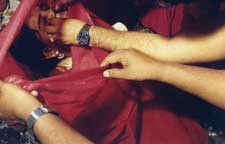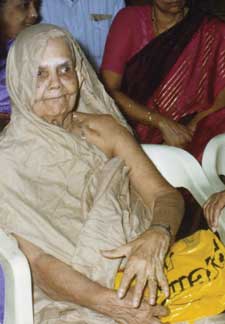Magazine
Jai Hind

|
About once a month, I get a Jai Hind e-mail from my uncles and aunties in the United States who want to remind the children of the diaspora of India’s strength and power. India invented chess, these e-mails say. India invented the number “zero.” Though Indians comprise under 1 percent of the U.S. population, A percent of doctors in this country are Indian; B percent of NASA scientists are Indian; X, Y, and Z Indians are the leaders of Fortune 500 companies.
But their authors, so quick to celebrate what is good about India and Indians, are equally quick to cry foul when the media highlights failures of Indian society. Take, for example, the controversy still surrounding Deepa Mehta’s movie, Water, a scathing hreflection on the low place women held in the Indian society of the 1930s. Met with riots during filming, the film has yet to be released in India because of backlash from Hindu fundamentalists, angered by what they consider historical inaccuracies and exaggeration. Women have been and are treated fairly, they say. Why does the Western press covering this movie discuss gender issues in totally unrealistic terms, when Hinduism is and has always been beyond gender inequality? Look at Draupadi – she had five husbands! And yet, potential inaccuracies and exaggeration aside, Mehta’s point is fact: Indian culture in the 1930’s was severely patriarchal. Examples abound even from my own family. Several of my great-grandaunts, married when they were barely nine and widowed shortly thereafter, had to keep their heads shaved and wear a brown wrap for the rest of their lives. Defiance of this tradition came at a high price: my great-grandmother, widowed at 21, refused to parcel her four small children to various relatives, refused to shave her head and be secluded from society. She was ostracized, excommunicated from all her husband’s relatives. Uneducated, she had to go to school to qualify herself to eke out a life for her and her children. She never wore jewelry or flowers for the rest of her life. She never attended the religious functions of weddings, because her presence would have been considered inauspicious. Widowers, however, could remarry and lead normal lives. The women of my grandmother’s generation were all married by the time they reached puberty.One of my grandaunts, wedded as a child, ran away from her husband because she feared the idea of sleeping with a stranger.Her parents convinced her to return to my granduncle, who had remarried by then, making her an unwilling participant in a polygamous marriage.In my parents’ generation, few women were allowed to go to college. Several of my aunts were “sold” in arranged marriages for family prosperity and ended up wedded to men who abused them. They could not divorce – to do so would bring shame onto the family.By contrast, I have uncles who were encouraged to get divorced because of incompatibility or because their wives had preexisting health problems. Even in my generation, education for a woman takes second seat to getting married. Two of my cousins were married against their will and have since left their husbands. They decided to brave the social stigma of divorce rather than be fettered unhappily like their mothers. These young women are barely 24. The above examples are anecdotes of a wider and more pervasive phenomenon that still exists today, even among the more educated people. I call it the “orthodoxy of Shiva Lingam.” When a woman is pregnant for the first time, she might have a Seemantham, where milk from a cow that has just given birth to a bull is snorted through the expectant mother’s nose. This is done to pray for the child to be a boy. A standard blessing by elders says, “May you be the mother of a thousand sons.” When I was born, the second daughter, my mother’s aunts wrote her to say “Better luck next time. You must try again for a boy.” When my uncle had a second child, a boy, a grandaunt called my mother to say in orgasmic joy, “Only now have you become an Athai, an aunt!”oblivious of the irony: my mother is the first born child of her parents-were they not parents until they had a boy? And was my mother not a mother, because she had two daughters and no sons?
A man who has sired a direct line of three males is granted an automatic ticket to heaven, an occurrence honored in South India with a Kanagabishekam, which my grandfather celebrated in grand style. A woman, when she has her period, is considered an untouchable and must eat alone, sleep on the floor and not touch anyone lest she contaminate others by proxy; everyone knows of her condition. I observe this tradition when I visit my grandparents and it is incredibly embarrassing and awkward that all the males in the family know when I am menstruating. Members of my mother’s and grandmother’s generation immediately take purifying showers if they inadvertently come into contact with me during this time. And so on. All this translates into an environment that allows and condones male chauvinistic behavior. Every young Indian woman I know has been the victim of “eve-teasing” and harassment when she dared venture onto Indian streets by herself in broad daylight. Families in India practicing prenatal selection abort more than half a million female fetuses each year, according to a BBC report. And a Times of India article reported that a textbook in western India says that a donkey is like a housewife because donkeys “toil all day and…maybe give up food and water…[except that donkeys are] a shade better, for while a housewife may sometimes complain…you’ll never catch the donkey being disloyal to his master.” It is true that the Western press plays up these stories and stories of bride burning instead of emphasizing stories about how so many Indian women are qualified doctors, engineers, computer whizzes, politicians. Although I too do not appreciate the propensity of the Western press to assign its own values on India, the irony doesn’t escape me: Indian women have come a long way in intellectual freedom, but they have not come all the way in social freedom and equality, values that as a woman in America I see as natural rights that all societies should strive to attain. Yes, India invented chess and the number ‘zero.’ Yes, 5 percent of doctors in this country are Indian; a high percent of NASA scientists are Indian; several Indians are leaders of Fortune 500 companies. But let us not bundle the truth in a nine-yard sari. Women have been and still are second-class citizens in Indian society. If we cannot be honest within our culture group, how can we expect others, like members of the Western press, to accurately portray us? Forget about how the press perceives us -if we cannot critique our own culture and our own history, how can we progress as a society? Hindus wash their feet before entering a temple, a literal and symbolic gesture to clean off grime and to purify themselves before entering the house of God. Let us follow this example and recognize that our culture, in its treatment of women, has stepped and continues to step in muck. Only then can we wash this filth away; only then can the rest of the world see us as we want to be seen. Only then, with clean feet, can we step forward. |


